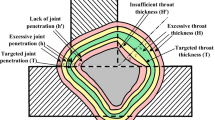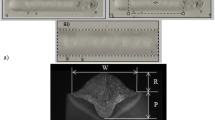Abstract
Nondestructive techniques for appraising gas metal arc welding(GMAW) faults plays a very important role in on-line quality controllability and prediction of the GMAW process. On-line welding quality controllability and prediction have several disadvantages such as high cost, low efficiency, complication and greatly being affected by the environment. An enhanced, efficient evaluation technique for evaluating welding faults based on Mahalanobis distance(MD) and normal distribution is presented. In addition, a new piece of equipment, designated the weld quality tester(WQT), is developed based on the proposed evaluation technique. MD is superior to other multidimensional distances such as Euclidean distance because the covariance matrix used for calculating MD takes into account correlations in the data and scaling. The values of MD obtained from welding current and arc voltage are assumed to follow a normal distribution. The normal distribution has two parameters: the mean µ and standard deviation σ of the data. In the proposed evaluation technique used by the WQT, values of MD located in the range from zero to µ+3σ are regarded as “good”. Two experiments which involve changing the flow of shielding gas and smearing paint on the surface of the substrate are conducted in order to verify the sensitivity of the proposed evaluation technique and the feasibility of using WQT. The experimental results demonstrate the usefulness of the WQT for evaluating welding quality. The proposed technique can be applied to implement the on-line welding quality controllability and prediction, which is of great importance to design some novel equipment for weld quality detection.
Similar content being viewed by others
References
LEE H T, WANG M, MAEV R, et al. A study on using scanning acoustic microscopy and neural network techniques to evaluate the quality of resistance spot welding[J]. International Journal of Advanced Manufacturing Technology, 2003, 22(9–10): 727–732.
KRAILJ V. Biocybernetic investigations of hand movements of human operator in hand welding[J]. IIW/IIS Doc, 1968: 212-140–68.
JOLLY W D. Acoustic emission exposes cracks during welding[J]. Welding Journal, 1969, 48: 21–27.
ARATA Y. Investigation on welding arc sound[J]. Report 1, IIW Doc.S.G.1979: 212?451-79.
ARATA Y. Investigation on welding arc sound: vibration analysis of base metal during welding[J]. Transaction of JWRI, 1981, 10(1): 39–45.
MAYER J L. Application of acoustic emission to in process monitoring of submerged arc welding[J]. IIW Doc V-WG, 1987: 3?29-87.
ROSTEK W. Investigation on the connection between the welding process and airborne noise emission in gas shielding metal arc welding[J]. Schweissen Schneiden, 1990, 42(6): E96–E97.
GRAD L, KRAILJ V. On line monitoring of arc welding process using acoustic signal[C]//Proceedings of the 13th Conference, Zagreb, 1996, I.17–I.20.
LIN J, QU L S. Feature detection and fault diagnosis based on continuous wavelet transform[J]. Chinese Journal of Mechanical Engineering, 2000, 36(12): 4867–4873.
MI M, MILLER B, KITA A, et al. Development of automated real-time data acquisition system for robotic weld quality monitoring[J]. Mechatronics, 2002, 12(9–10): 1259–1269.
LADISLAV G, JANEZ G, IVAN P, et al. Feasibility study of acoustic signals for on-line monitoring in short circuit gas metal arc welding[J]. International Journal of Machine Tools and Manufacture, 2004, 44(5): 555–561.
KAMAL P, SANDIP B, SURJYA K P. Investigation on arc sound and metal transfer modes for on-line monitoring in pulsed gas metal arc welding[J]. Journal of Materials Processing Technology, 2010, 210(10): 1397–1410.
WANG Y W, ZHAO P S. Noncontact acoustic analysis monitoring of plasma arc welding[J]. International Journal of Pressure Vessels and Piping, 2001, 79(1): 43–47.
LU X Q, ZHANG K, WU Y X. Condition and expectation of automatic seam tracking system[J]. Chinese Journal of Mechanical Engineering, 2003, 39(12): 4867–4873.
PATRIZIA S, DARIO D B. On-line optical monitoring system for arc welding[J]. NDT & E International, 2002, 35(1): 37–43.
JOHANNES R, JURGEN B, MARIO L. Quality evaluation in resistance spot welding by analysing the weld fingerprint on metal bands by computer vision[J]. International Journal of Advanced Manufacturing Technology, 2007, 33(9–10): 952–960.
JUANG S C, TARNG Y S. Process parameter selection for optimizing the weld pool geometry in the tungsten inert gas welding of stainless steel[J]. Journal of Materials Processing Technology, 2002, 122(1): 33–37.
PAN L K, WANG C C, WEI S L, et al. Optimizing multiple quality characteristics via Taguchi method-based Grey analysis[J]. Journal of Materials Processing Technology, 2007, 182(1–3): 107–116.
TARNG Y S, YANG W H, JUANG S C. The use of fuzzy logic in the Taguchi method for the optimization of the submerged arc welding[J]. International Journal of Advanced Manufacturing Technology, 2000, 16(9): 688–694.
LI Z Y, WANG B, DING J B. Detection of GTA welding quality and disturbance factors with spectral signal of arc light[J]. Journal of Materials Processing Technology, 2009, 209(10): 4867–4873.
WATANABE Y. Practice Taguchi methods[M]. Tokyo: JUSE Press, 2006.
Author information
Authors and Affiliations
Corresponding author
Additional information
Supported by Ningbo Municipal Natural Science Foundation of China (Grant No. 2014A610063)
FENG Shengqiang, born in 1979, is currently an associate research fellow at Ningbo Branch of China Academy of Ordnance Science, China. He received his PhD degree from Tianjin University, China, in 2010. His research interests include Welding, Coatings and Surface Treatments.
TERASAKI Hidenri, born in 1974, is currently an associate professor at Joining and Welding Research Institute, Osaka University, Japan. His research interests include Materials Processing Engineering.
KOMIZO Yuichi, born in 1950, is currently a professor at Joining and Welding Research Institute, Osaka University, Japan. His research interests include Materials Processing Engineering.
HU Shengsun, born in 1955, is currently a professor at Tianjin Key Laboratory of Advanced Joining Technology, Tianjin University, China. His research interests include Welding Automation.
CHEN Donggao, born in 1970, is currently a research fellow at Ningbo Branch of China Academy of Ordnance Science, China. His research interests include Welding Technology and Welding materials.
MA Zhihua, born in 1982, is currently an engineer at Ningbo Branch of China Academy of Ordnance Science, China. His research interests include Welding Technology and Welding materials.
Rights and permissions
About this article
Cite this article
Feng, S., Terasaki, H., Komizo, Y. et al. Development of evaluation technique of GMAW welding quality based on statistical analysis. Chin. J. Mech. Eng. 27, 1257–1263 (2014). https://doi.org/10.3901/CJME.2014.0718.120
Received:
Revised:
Accepted:
Published:
Issue Date:
DOI: https://doi.org/10.3901/CJME.2014.0718.120




